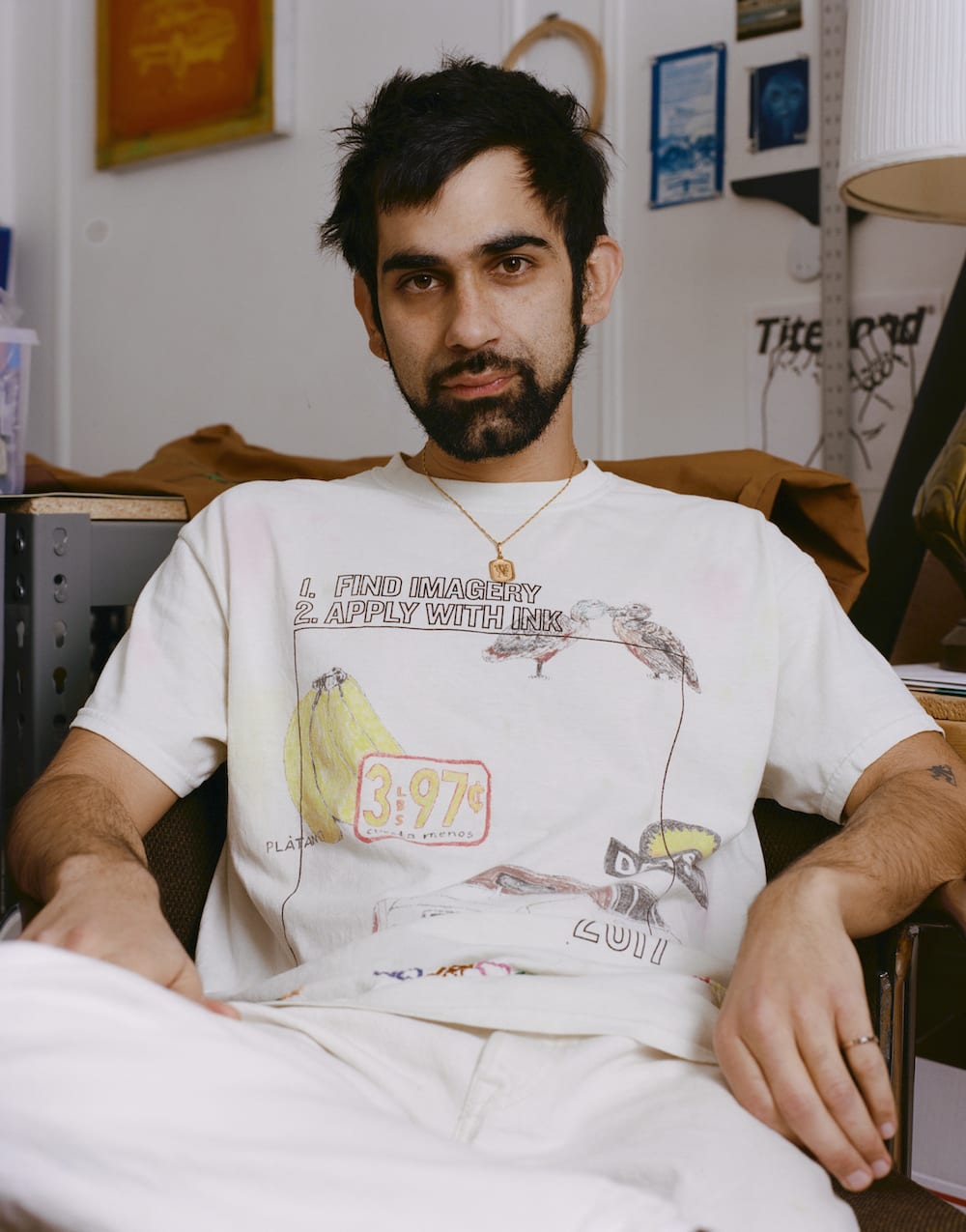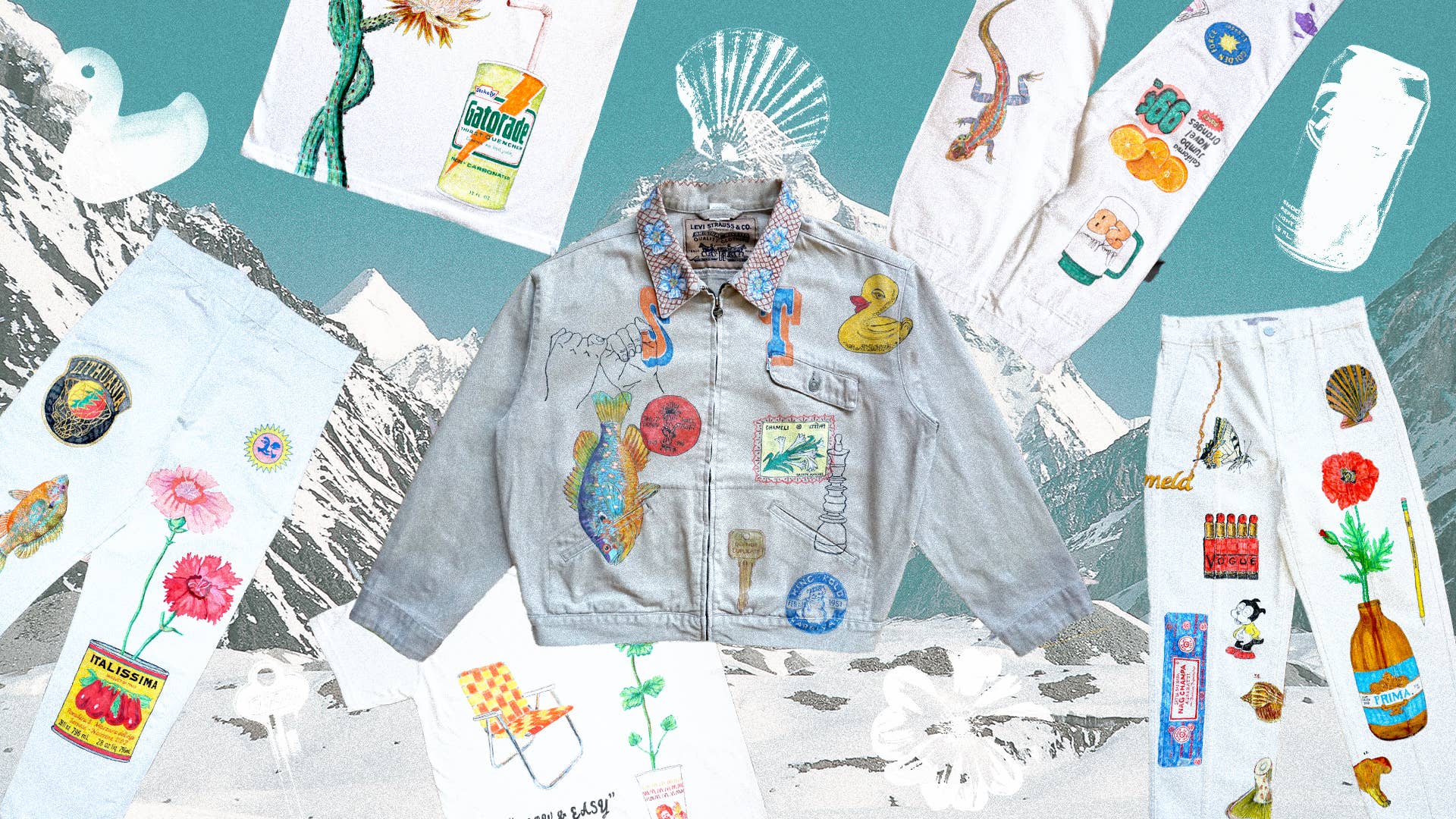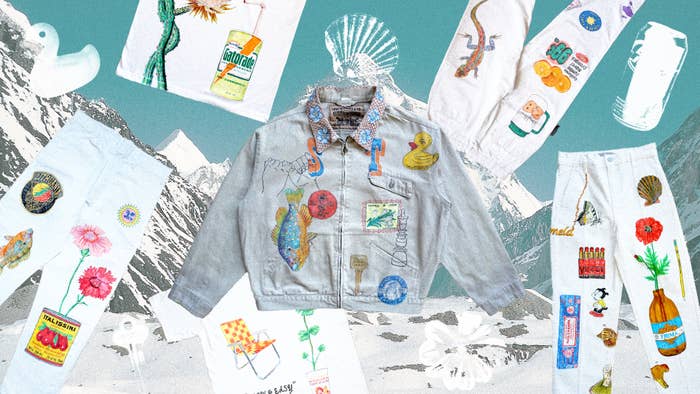
Nicholas Williams is unsure exactly how his bespoke clothing brand, Small Talk Studio, caught the eye of Virgil Abloh, who recently commissioned the artist to draw and embroider images on his clothes. But it’s clear that the 30-year-old artist lets his garments, which are really mixed-media paintings, speak for themselves.
“Pandemic aside, people are definitely looking for clothing that has a little more of a personal touch. They want something that is one of a kind that either only they have, or only a few people in the world have,” Williams tells Complex over the phone from his studio in Sunset Park, Brooklyn. “Also, people are ready to get back out with some loud pieces to wear.”
Since 2017, Small Talk Studio has been building a cult following for crafting 1:1 handmade garments that feature Williams’ playful style of art. A formally trained printmaker with no background in fashion design, Williams decorates garments like trucker jackets, denim pants, T-shirts, and button-ups with fabric markers, embroidery, and cyanotype patches. The result is unique designs that no screen printer or Photoshop could emulate. His work is reminiscent of “Senior Cords,” an early American 20th-century fashion trend that’s been revisited by designers like Ralph Lauren, Emily Bode, and other young “DIY” streetwear designers. However, unlike Lauren or Bode, Small Talk Studio’s designs are rooted in nostalgia rather than Americana. This shines through with Williams’ detailed renderings of beloved supermarket products and the personal mood boards clients send in to inform his custom designs.
“When I worked on those pieces for Virgil Abloh, that was all very planned out from the beginning,” says Williams, who drew in references to artists like Noah Purifoy and David Hammons based on a moodboard Abloh sent in. “Even though I only included a few references like that on there, there were a lot of things I was toying around with. It was cool to situate his work in a legacy of a lot of these other artists who he hinted at wanting to include on here.”
We spoke to Williams to learn about how he launched Small Talk Studio, what his artistic influences are, the beauty of food packaging, and how he plans to scale up his unique DIY clothing brand.
How old are you and where are you from?
I just turned 30 this past weekend. I’m originally from Nashville but lived in California for the last 10 years. I moved to New York in 2019.
How did you first start making art or clothes in general? I heard your grandmother taught you how to embroider. Does that talent run through your family?
Actually, that’s a good way of putting it because I definitely learned from her. But honestly, I’ve been learning little things like that from other members of my family since I was a kid. My dad and my grandpa had a woodshop and they taught me carpentry when I was growing up. I studied printmaking when I was in school. So I was pretty into that for a while and was more on the fine art side of things until three or four years ago when I was visiting my grandma and she taught me how to embroider. And yeah, I started making pieces for friends and it just ballooned out from there.
So, you started making clothes during your time in college?
Yeah, a little bit. When I was in college, I was doing a lot more work on paper and sculpture. I worked for a couple printmakers and a furniture maker. So I didn’t start making clothes until probably 2017 or so, when I was living in Oakland. It was just a way to connect with people a little bit more. Because when making art, you do connect with people every now and then, but I think there’s something a little more personal about making something people wear. It took a couple years to fully make that transition. I’ve always had clothing that I’ve been interested in. But as far as actually learning to make clothing that I was happy with, and that I felt would look good on people, it probably took me a good two years of trial and error before I started making things I was really stoked on.
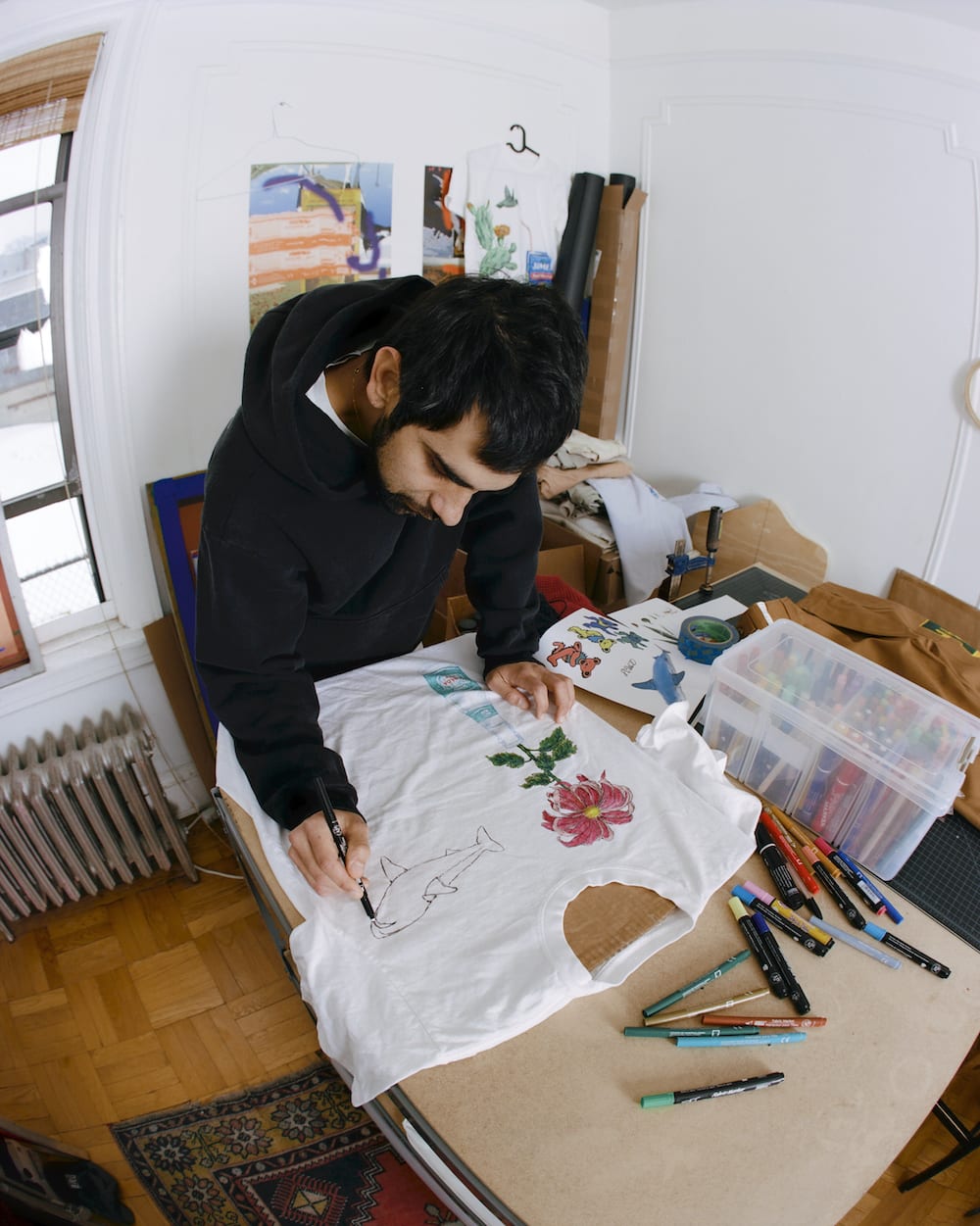
Small Talk Studio is four years old now. How did you first get the idea to start painting and embroidering these garments?
I feel like it was kind of a natural evolution from doing a lot of printmaking, where I was used to working with different media and layering imagery and text. And I think it came out of a time when I renewed my own interest in clothing. You know, cultivating personal style and all these other things that I had been interested in, passively, for a long time. I think around that time was when I started taking that a little more seriously and experimenting with clothing. But yeah, it definitely started with the embroidery. And I would always draw the imagery on before I started stitching. But then I realized that I could probably do a lot more by actually drawing directly on clothes because it takes half the time and you’ve got a lot more at your disposal as far as colors and creating depth.
Off the jump, did you see Small Talk Studio as a brand?
I think when I first started doing it, I just saw it as another creative practice as a hobby. But ultimately, I wanted to be able to do this as a job. And during the first couple years, that didn’t really seem attainable. And then, the last year I was in Oakland in 2018, I started reaching out to other artists and designers who I saw were doing similar things—a lot of custom one-on-one clothing or just making art out of clothing. I organized this big DIY fashion show in Oakland with 30 other artists. And that was when I was like: “OK, I could see myself maybe getting to the point of doing this full time.”
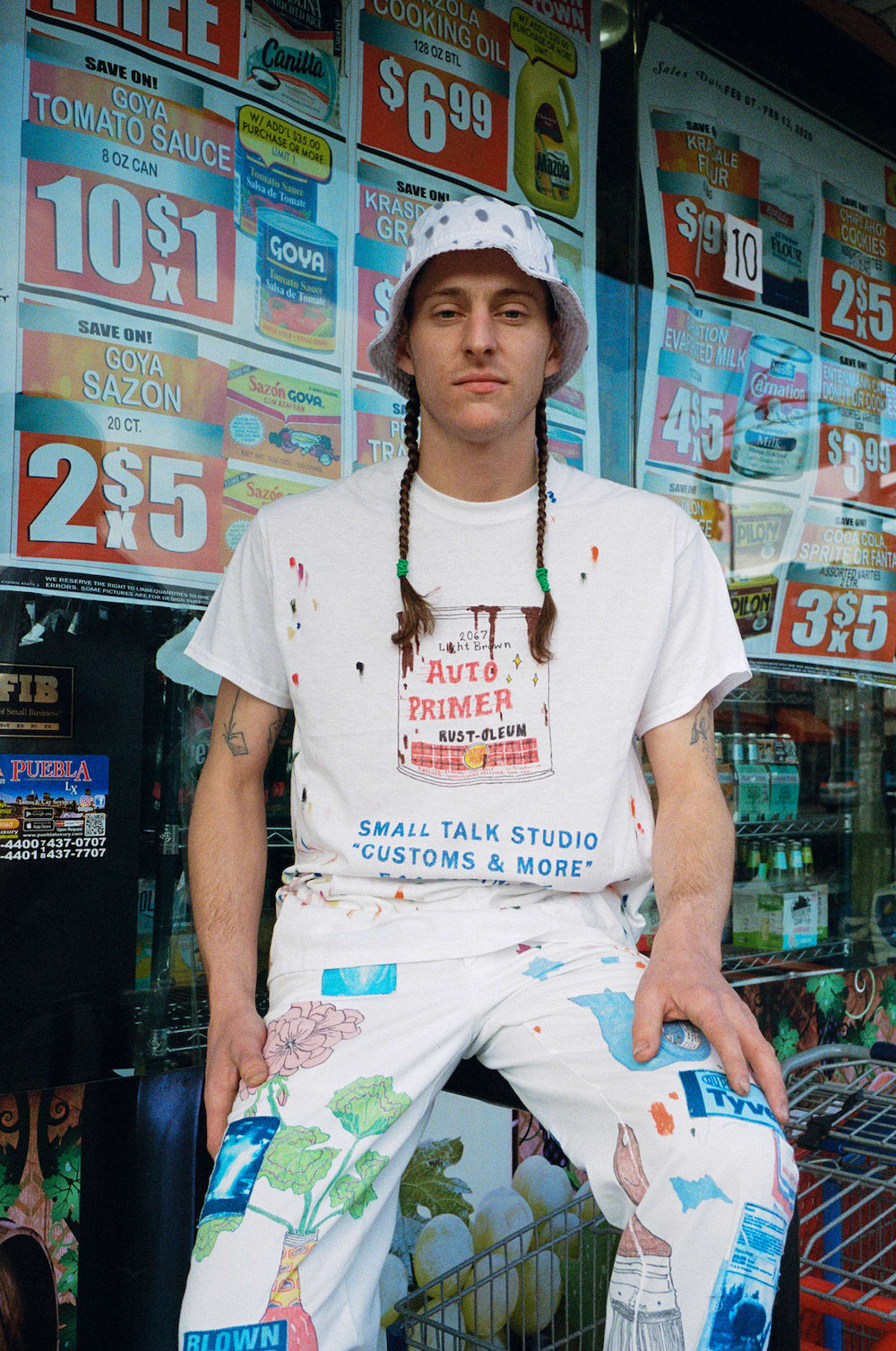
Did that motivate you to move to New York last year to pursue this?
Yeah, it definitely helped. To be honest, I was moving here already because my girlfriend had moved here the year before to go to grad school here. So I was planning on moving sometime in 2019. But it just helped that New York was also a better place to take a practice like this a little more seriously and to get to know some more people. And honestly, people dress a lot better in New York than they do in the Bay Area.
When I first saw your work it reminded me of “Senior Cords” and pop art centered around supermarket food by artists like Tom Wesselmann. Are there any designers or artists that inspire your work?
Yeah, for sure. There’s a lot of different designers that I would say I’m directly and indirectly inspired by. Obviously, a lot of what Bode does is in the same vein of what I’m trying to make. But I think what they make is a little more dialed in to a particular type of heritage Americana. They have a practice that I think is a little more specific than what I’m trying to do. I’m also a huge fan of brands like Bode and Adish Studios for creating a line of simple but elegant silhouettes and using things like heritage fabric selection and artisan techniques as tools to keep their collections fresh and interesting. I think it’s a cool way to make things that are super versatile and kind of timeless. I love Brain Dead and Stüssy because they have the confidence to put lifestyle ahead of fashion and create these ever-expanding creative communities by incorporating all kinds of collaborations into so much of what they make. And of course they’re both powerhouses when it comes to graphics and messaging.
I’ve always been a huge fan of John Baldessari and got an opportunity to work on a set of prints he was doing with the place that I worked at in LA, back in 2015. I’m also a big fan of Peter Sutherland’s work as a photographer and mixed-media artist. I’ve always been drawn to photographers who are openly immersed in subcultures and capture the spirit of the people who make them. His work is inspiring to me because I feel like there is a language and story to the whole body of work that is self referential and keeps building on itself in interesting ways. I love the way he seamlessly incorporates all these disparate visual elements and creates something unique and compelling.

And there’s also an artist who I got to know a little bit when I was living in Oakland, a painter named Grace Rosario Perkins. I love the visual world she creates and the way her paintings and drawings inform the clothing she makes. Everything is infused with a strong DIY ethos but also grounded by a really obvious commitment to craft and personal narrative. I also just love her personal style and feel like there is a sort of synergy between the way she dresses and the art she makes.
I also really love watching artists whose practice encompasses painting, sculpture, and collage, while also making clothing, with very little distinction between these different forms of media. So I have always loved UDLI Editions by Jason Wright and Come Tees by Sonya Sombreuil. Both loom large in terms of laying the groundwork for an ever-growing group of young contemporary artists and designers carrying on the legacy of DIY clothing and art-making.
I mean I could go on forever naming designers, brands, artists who I feel inspired by. I think one of the best parts about getting to do this full time now is that I have the space to experiment and really try out all of these ideas that come from watching and learning from what other artists and designers I love are doing.

What do you love about packaging? I feel like your clothes have made me look at a bottle of Texas Pete’s Hot Sauce and Clorox Bleach in a whole new light.
That’s rad because I feel the same way after I draw something like that. I feel like there’s certain things that I see over and over again and the branding gets stuck in my head, which probably happens to everybody to some degree. Sometimes it’s annoying to be bombarded by certain branding. Some branding could also represent all kinds of bad things, but I’m just fucking with the label and the art that goes into it. And a lot of times, food and the packaging it comes in is strongly linked to memory or nostalgia which often holds a pretty significant place in people’s minds. I also always loved the juxtaposition of commercially produced imagery and things from the natural world. I draw a lot from botanical illustrations, nature guides, and archival photography that I find online. I think it’s an unexpected combination that can be fun.
I hear that it takes about three to four months to get a piece from Small Talk Studio and that you only produce about 50 pieces every four months. What’s the process like from start to finish for custom orders? How long does it take for you to finish one garment and how do you know you’re done?
I think that part of the reason the process takes awhile is because up until now, I’ll start with one or two images that I know I want to put on a piece. They’re usually larger images that take up a good chunk of space and then I’ll just work it out from there, start placing things around, and see how it works. So just planning it out, and the process of trying out different imagery and text in different places, all ends up taking me quite awhile. But it’s gotten a little faster. I would say a pair of pants or a jacket will take a good three or four full days of work. But a shirt, or something that I’m just working on one side of, I can usually do in a day or a day-and-a-half.
I know when I’m done because there’s just a certain balance that I’m looking for. Usually, I’ll just know. I’ll get to a point where I’m like, “All right, there’s probably room for two or three more things on here and once I have those, this’ll probably be done.” Sometimes, that’s right, sometimes I’m like, “All right, I got to put one more thing in there just to fill this out.” But usually, I know as soon as I put that last piece on there that it’s ready to go. Sometimes, I’ll even plan out a whole leg of a pair of pants or the whole back design on a jacket before I even start drawing it. But for the most part, it’s all just an organic process of trying different things out and seeing what works.
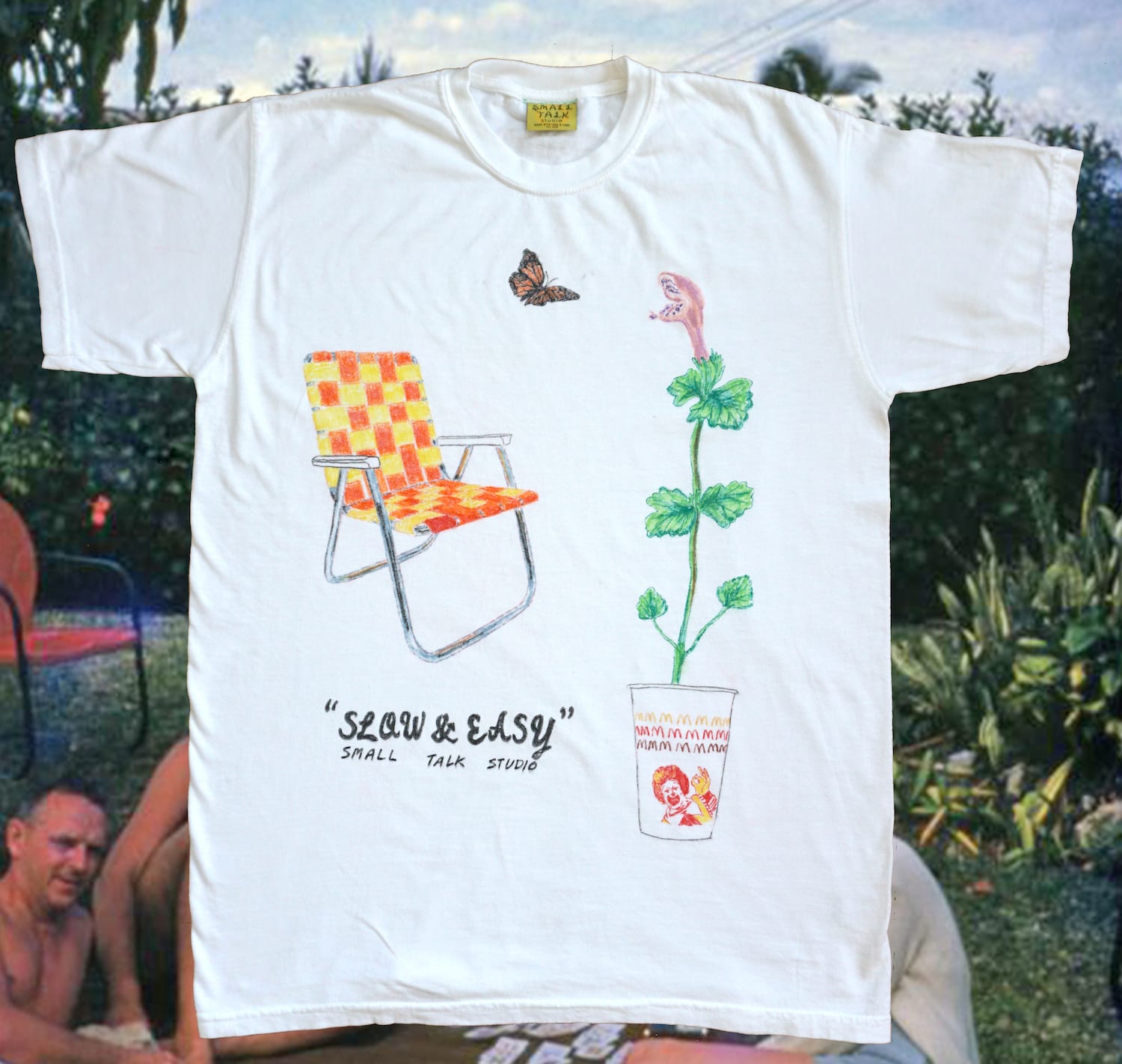
I assume that when clients buy this stuff, they just get the product eventually and that’s when they finally see it. Or do you send pictures to them throughout the process?
Sometimes, people will ask me for pictures. And a couple of times, when I’ve worked with a stylist or an assistant for somebody, they’ll really want pictures or ideas upfront because it might be for a specific purpose. Like when I worked on those pieces for Virgil Abloh, that was all very planned out from the beginning. He had a specific set of imagery that he wanted to see on there and I improvised it a little bit and worked off of what he had sent me. But he had a very specific mood that he was going for. That happens sometimes. But for the most part, people don’t see it until they get it in the mail.
And I’m definitely trying to keep that process alive. But at the same time, I’m also hoping to change up the system a little bit this spring since I’m also putting out some premade or pre-designed items, where I’ll post something and be like, “All right, I’m going to make five of these,” or, “I’ll make 10 of these.” It’s something where you can see the design upfront but it’s still a hand-drawn piece. I think it’ll allow me to think of a few more pieces and meet that demand a little more. And also, I think there are certain people out there who would rather know what they’re getting upfront. So, I’m going to try that out and see how it goes.
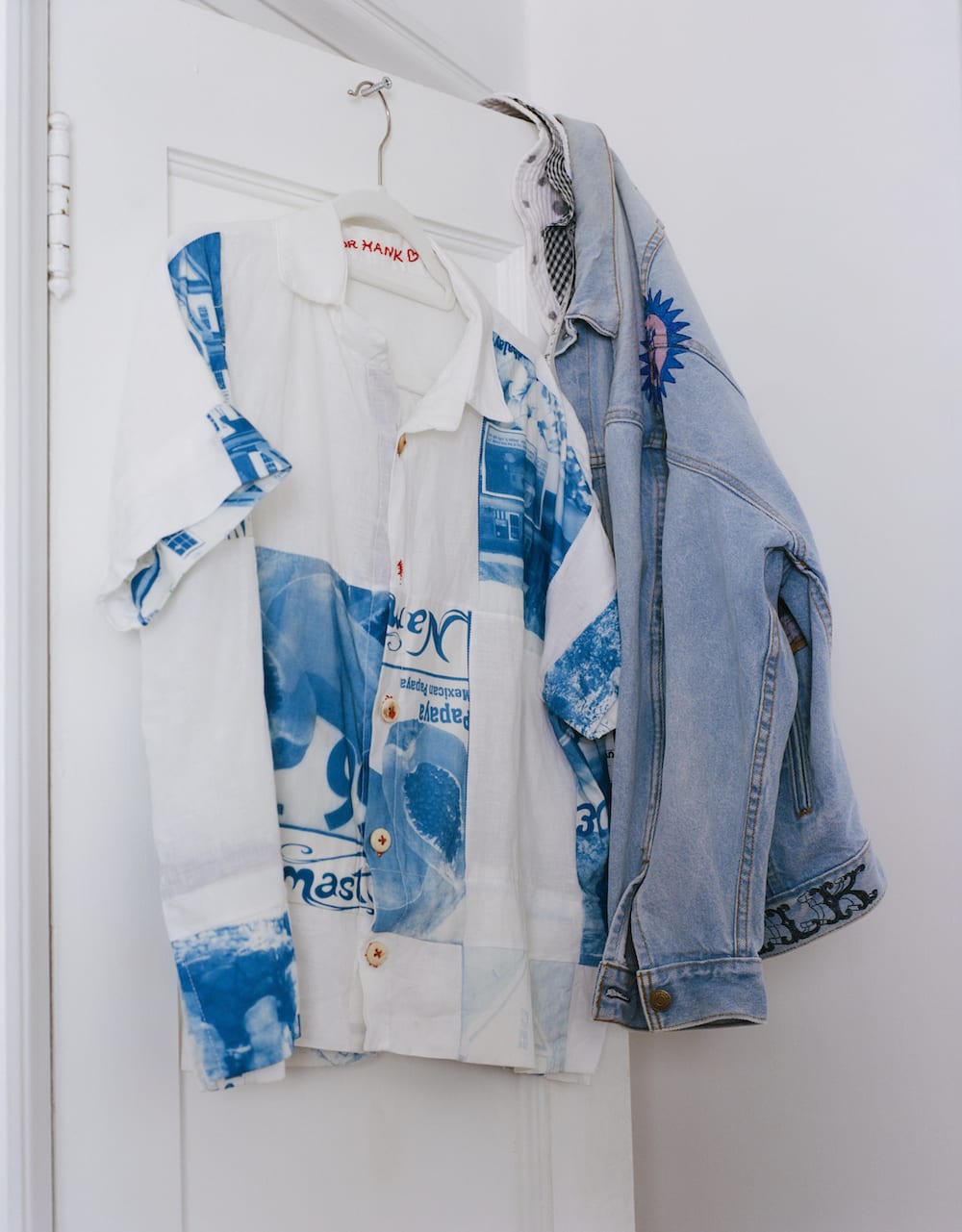
It makes sense that you told me that you learned printmaking in school. Because I was about to say, I love the cyanotype stuff you put into your work, too. Is that difficult to do? And aside from embroidery and fabric markers, do you use any other crazy materials when you make your garments?
So, the cyanotypes, they’re fairly easy to do as long as you have good sunlight. It’s a little bit of a time-consuming process, but it’s really just a matter of getting the exposure time dialed in and having some good sunlight. That’s also much easier to do in the summer. But that’s probably the most out-there process that I use in terms of what people are accustomed to seeing on clothing. I’m always trying to learn new embroidery stitches and I’m trying out little things like fabric paint in certain areas so it’s not all marker. But at this point, I feel like I’ve gotten a few things pretty dialed in and I’m trying to just keep building on those things for the most part.
I see that clients like Virgil Abloh have sent you moodboards to inform your designs. What were some of the most interesting images, themes, or concepts that clients have specially requested from you?
Well on his pieces, I was really excited that he sent me David Hammons’ African-American flag. I had known David Hammons’ work for awhile and there were quite a few different sculptures and pieces that I thought would be fun to draw and include in there. It just took me on this journey of exploring the work of a lot of different Black artists who were making work from the ‘70s through the ‘90s. And even though I only included a few references like that on there, there were a lot of things I was toying around with. And yeah, it was cool to situate his work in a legacy of a lot of these other artists who he hinted at wanting to include on here.
When I first started taking commissions, people were sending me stuff that I wasn’t necessarily hyped to draw. Although it was personal to them, they might have not thought about whether it would translate well into a drawing or not. But now that people have seen my work for the past year or so, people now have a pretty good idea of what works to draw and what doesn’t. So, I’ve gotten a few requests for some furniture pieces, some iconic chairs and things that I’ve really enjoyed drawing and researching in the process.
This wasn’t a request, but one thing that I always wanted to draw or include in an art piece were these cellphone towers that are designed to look like palm trees. Drawing that on a jacket was a lot of fun because it was just something I saw all the time when I was living in LA. I was always weirdly drawn to those things. For me, it’s just fun mixing and matching all kinds of seemingly unrelated stuff and seeing how it goes together once I draw it.
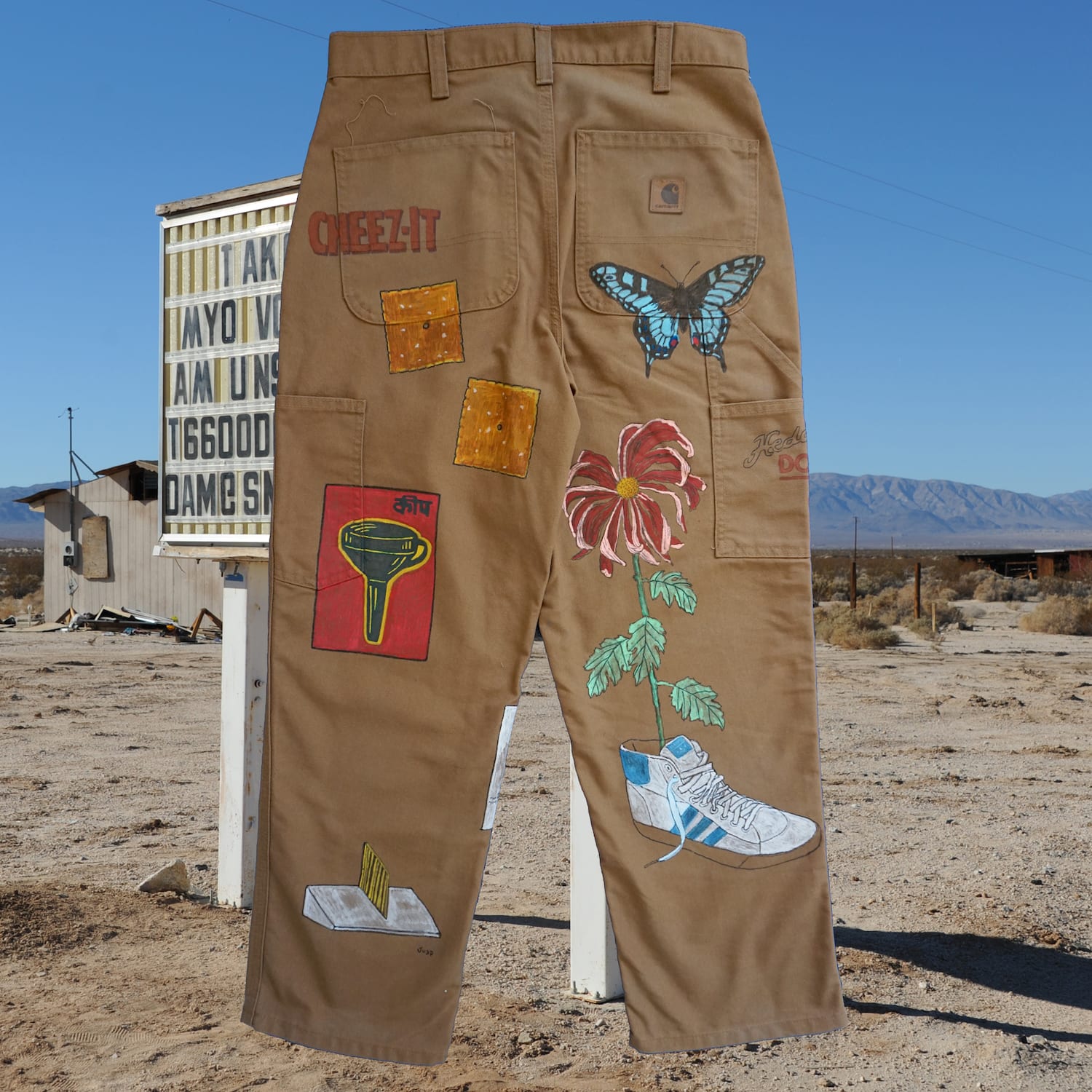
And if anyone wants to send you something to work with, what materials or garments would you suggest them to commission for the best results?
So I’ve had some patterns made recently and I was asking myself that same question. I was trying to figure out what the perfect pair of pants, jackets, and button-down shirts would be for drawing on or for any kind of process that I might do to a garment. So, I actually just started collecting some vintage garments that, to me, were the perfect fit and material for what I’ve been doing. Hopefully in March or April I’m going to release a line of in-house garments that I’ll have as base garments to work on. So I have a pair of pants that’s based on a silhouette, similar to an ‘80s painter’s pant, but it’s got some more refined detailing to it and it’s made with a lightweight cotton herringbone twill. And then there’s a trucker jacket and a boxy button-down shirt.
But I’m still going to accept special jackets or pairs of pants that people already own, which they want me to work on. So really anything that’s on the lighter side, like white, beige, or light brown, is easiest to get markers or thread to show up on. Heavier-weight cotton materials, like twill, canvas, or denim, is also what I’m looking for because up until now, I’ve sourced most of the garments. So yeah, there’ll be a couple of different options, but I’m pretty hyped on having some in-house garments that I’ve helped design. So, we’ll see how that turns out.
Since each piece requires your full attention, it must be challenging to widen the brand’s distribution. What are your thoughts on getting your clothing into department stores? Or would you rather keep it direct to the consumer?
Kind of a mix. It’s something I’ve been thinking a lot about in the last few months. So, I’ve brought on a friend to help me run the operation and to also help produce some of these garments. Our plan right now is to scale up a little bit just in terms of how many orders we can take. And also, we’re going to have a few cut-and-sew items made throughout the course of this year, that we’re talking to a few different small stockists about. So right now, if I like the roster of designers that a certain stockist has been working with, or just the general ethos that they bring, then I’m always open to working with people who want to do wholesale or that kind of thing.
There will always be the direct-to-consumer side of things as well because I love the process of talking to people, talking through what kinds of things they want to see on a garment, and the whole collaborative process of it. So this year is going to be a big one for expanding, but I’m definitely trying to keep it still at a manageable level. I just want to have more to offer and try to meet some of the demand that has come my way in the last year or so.
